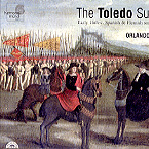These days a major event usually is accompanied by swarms of television cameras, blathering announcers, and the very latest “hot” pop star prancing, leaping, and (badly) lip-synching to some canned, ultimately forgettable electronically processed McMusic. How far we’ve come in the 500 years since the occasion commemorated on this CD–the ceremonial visit of Philip the Fair of Burgundy to Spain, hosted by King Ferdinand and Queen Isabella! In addition to the banquets, outdoor recreations (including a battle re-enactment), and church services, the five-month-long stay involved numerous musical performances, utilizing the considerable talents of the most prestigious Aragonese and Castilian choirs in addition to the hand-picked band of Burgundian singers and composers Philip brought with him. Although we don’t know exactly what was sung at these events, including liturgical ceremonies at Toledo Cathedral, we do know who the composers on the scene were, and combined with other information found in contemporary songbooks and other documents, we can speculate with some reliability.
As explained in the detailed notes, The Orlando Consort–countertenor Robert Harre-Jones, tenors Charles Daniels and Angus Smith, and baritone Donald Greig–has chosen a program designed to “highlight” the summit’s main events through the music of the composers who were either present or whose works were part of the repertoire of the cathedrals and courts in question. It’s a welcome mix of sacred and secular, and includes the poignant Versa est in luctum (“My harp is turned to mourning”) by Peñalosa, which may have been sung at a memorial for Ferdinand and Isabella’s son-in-law who died during Philip’s visit. Agricola’s Je n’ay dueil (“I have no grief that does not come from you”) is a secular piece similarly compelling with its dolorous melody and affecting beauty, highlighted by countertenor Harre-Jones’ ideal, pure, plaintive vocal quality.
Throughout, the four singers seem completely focused on creating an ensemble whose sound takes a significant measure of its form from the music’s style and text–in other words, unlike many early music groups, this one doesn’t just deliver each piece with the same perfectly blended, elegantly shaped, yet homogeneous vocal character. The sad, contemplative, and more serious pieces immediately put us in that mood because the singers express the texts that way–not simply by modifying the tempo, but more by varying vocal color, reserving accents for only special moments, and allowing a particular voice prominence where the melody demands. This may or may not be completely conscious on the part of the singers–it may just be a result of their grasp of and immersion in the music–but it’s very effective nevertheless.
On the other hand, the livelier pieces–including an anonymous, 42-second-long song with ricocheting voices (“Now you dance; After you, after you,” etc.), La Rue’s Autant en emporte le vent (“So many does the wind carry off”), and Pedro de Lagarto’s Andad, pasiones, andad (“Go on, passion, go on”)–properly emphasize rhythmic (usually syncopated) features and take delight in shading certain words for their importance and special effect. The sophistication and sheer beauty of the two Peñalosa selections–including the closing piece, the Credo from his Missa L’homme armé–makes you wonder why more attention hasn’t been paid to this composer by early music groups.
Somewhere in the middle of this nearly 75-minute program some listeners may wish for an occasional break from the very distinctive four-voice a cappella sound–an instrumental piece or two?–but that’s purely a matter of choice. You don’t have to listen to the whole thing at once. And for most of us, hearing so much of this glorious, ancient music, expertly sung and ideally recorded, provides a happy respite in a world that in certain critical areas (except for those lip-synching, hyper-processed, tonally challenged pop stars) hasn’t really changed much in 500 years.
































